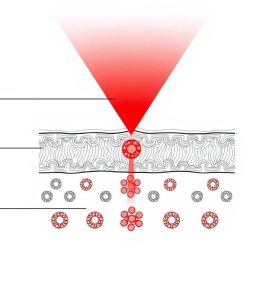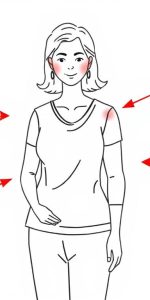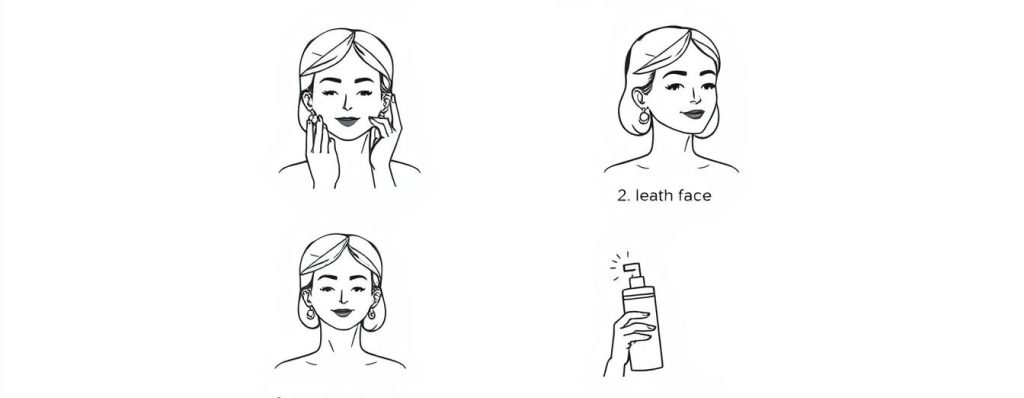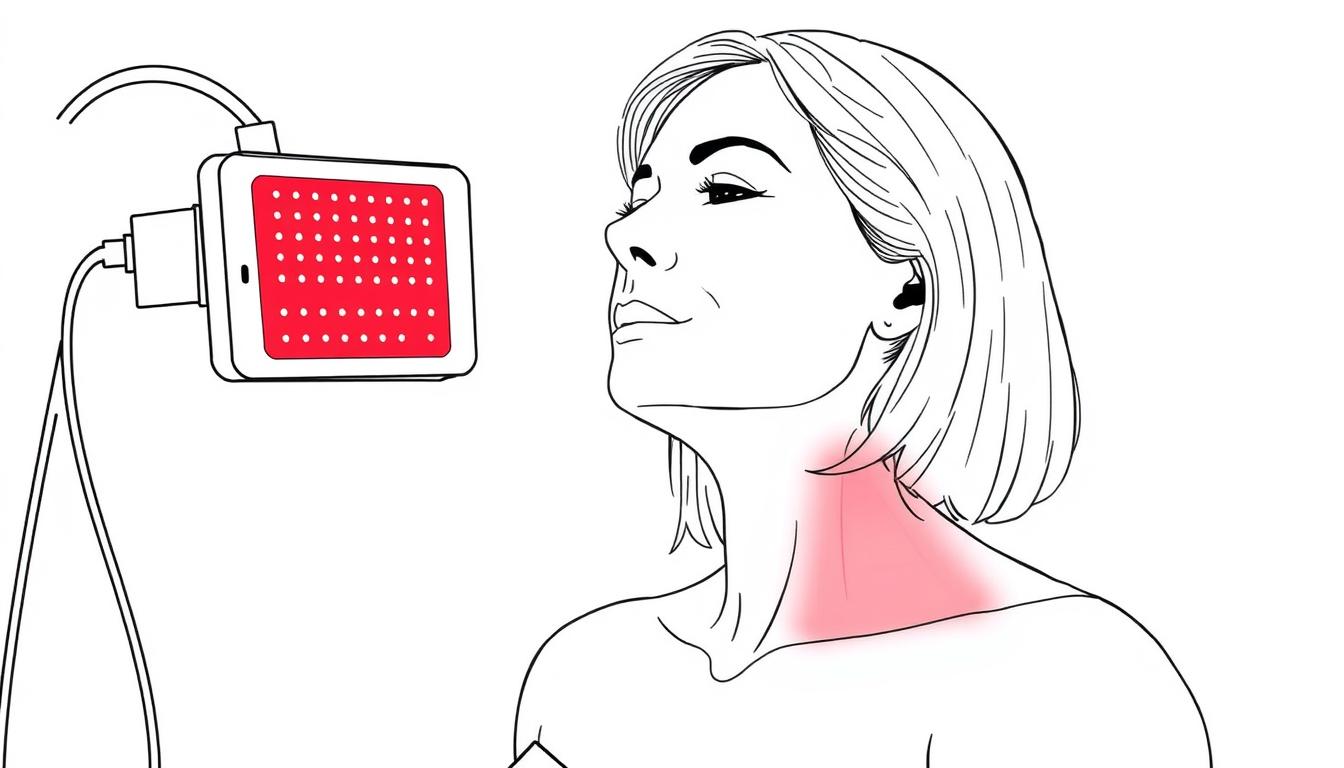Red light therapy (RLT) has emerged as a promising solution for skin tightening, supported by a growing body of clinical research. This guide examines the science behind red light therapy for loose skin, compares leading devices, and provides practical application advice for different body areas.
Understanding Loose Skin: Causes and Concerns
Loose skin occurs when the supporting structures beneath the skin’s surface begin to deteriorate. Several factors contribute to this common concern:
Natural Aging Process
As we age, our bodies produce less collagen and elastin—proteins responsible for skin’s firmness and elasticity. Studies show collagen production decreases by approximately 1% annually after age 20, accelerating to 2% after age 40.
Sun Exposure
UV radiation damages collagen fibers and causes abnormal elastin accumulation. Research indicates that up to 80% of visible facial aging stems from sun exposure rather than chronological aging.
Weight Fluctuations
Rapid weight loss, especially after obesity, can leave skin unable to contract to its new shape. The skin may have been stretched beyond its ability to recover, particularly after losing more than 100 pounds.
Lifestyle Factors
Smoking reduces blood flow to the skin and depletes vitamin C, essential for collagen production. Poor nutrition, dehydration, and lack of exercise can also accelerate skin laxity.
The Science Behind Red Light Therapy for Skin Tightening
Red light therapy, also known as photobiomodulation or low-level light therapy (LLLT), uses specific wavelengths of red and near-infrared light (typically 630-850nm) to penetrate skin tissue and trigger biological effects at the cellular level.
How Red Light Therapy Works for Loose Skin
Stimulates Collagen Production
Red light activates fibroblasts, the cells responsible for collagen synthesis. A landmark study by Avci et al. (2013) demonstrated that red light therapy at 633nm wavelength increased procollagen production by up to 31% after 12 weeks of treatment.
Improves Cellular Energy
Red light is absorbed by mitochondria, enhancing ATP production—the energy currency of cells. This boost in cellular metabolism accelerates repair processes and protein synthesis (Barolet et al., 2016).
Increases Blood Circulation
Improved microcirculation delivers more oxygen and nutrients to skin cells while removing waste products more efficiently. This creates an optimal environment for skin regeneration.
Reduces Inflammation
Red light therapy has anti-inflammatory effects that help calm irritated skin and create favorable conditions for healing and regeneration (Wunsch & Matuschka, 2014).

Clinical Evidence for Skin Tightening Effects
Multiple human clinical trials support red light therapy’s effectiveness for skin tightening:
- A 2014 study by Wunsch and Matuschka found that subjects receiving red light therapy (611-650nm) twice weekly for 30 sessions showed a 25-30% improvement in skin firmness and elasticity.
- Barolet et al. (2016) demonstrated that 12 weeks of red light therapy (660nm) reduced wrinkles by 36% and increased skin density by 16% compared to control groups.
- A 2020 study published in the Journal of Cosmetic Dermatology reported that participants using red light therapy showed significant improvements in skin laxity, with 85% of subjects reporting satisfaction with results.
“Red light therapy represents one of the most promising non-invasive approaches to skin rejuvenation, with multiple clinical trials demonstrating its ability to improve skin firmness, elasticity, and overall appearance without significant side effects.”
Comparing Red Light Therapy Devices for Skin Tightening
The market offers various red light therapy devices, from handheld units to full-body panels. Understanding the differences helps determine which option best suits your skin tightening goals.
Key Factors to Consider When Choosing a Device
Wavelength Specificity
The most effective wavelengths for skin tightening fall between 630-850nm. Research shows that 660nm and 850nm wavelengths penetrate to different skin depths, providing complementary benefits.
Power Density (Irradiance)
Measured in mW/cm², this determines treatment intensity. Effective devices typically deliver 20-100 mW/cm² at the treatment surface.
Treatment Area Size
Larger panels treat more area simultaneously, reducing session time but typically costing more. Targeted devices work well for specific areas like the face.
Treatment Time
Session duration varies based on device power. Higher irradiance devices may require shorter sessions (3-10 minutes) compared to lower-powered alternatives (15-30 minutes).
Leading Red Light Therapy Devices Compared
| Device Type | Best For | Treatment Area | Session Time | Portability |
| Handheld Wands | Targeted treatment of small areas | Small (2-4 in²) | 15-20 min per area | Excellent |
| Face Masks | Facial skin tightening | Medium (full face) | 10-20 min | Good |
| Small Panels | Face, neck, chest | Medium (12×12 in) | 10-15 min | Moderate |
| Large Panels | Full body treatment | Large (24×48+ in) | 10-20 min | Limited |
Top Brands and Their Unique Features
RLT Home
The Total Spectrum series offers seven clinically-validated wavelengths (630nm, 660nm, 810nm, 830nm, 850nm, 1064nm, plus 465nm blue) with zero measurable EMF at treatment distance.
Their Total Spectrum Compact (30×12 in, 216 LEDs) provides efficient coverage for torso or upper legs with pre-built modes for different treatment goals.
PlatinumLED
Known for exceptional durability and commercial-grade construction. Their BioMax series combines five wavelengths for comprehensive treatment but at a higher price point.
Excellent cooling systems allow for extended operation in professional settings.
Joovv
Features sleek, modern design with modular components that can be expanded over time. Their devices offer excellent aesthetic appeal for home use.
Provides good coverage with dual wavelengths (660nm and 850nm) but with fewer customization options.
Find Your Ideal Red Light Therapy Device
Not sure which device is right for your skin tightening needs? Compare leading red light therapy panels side-by-side to find the perfect match for your body area, budget, and treatment goals.
Treating Different Body Areas for Loose Skin
Different body regions require specific approaches for optimal results with red light therapy. Here’s how to address loose skin concerns by area:

Face and Neck
The face and neck show signs of aging first due to thinner skin and constant sun exposure. These delicate areas benefit from targeted treatment.
Recommended Approach
- Distance: 6-12 inches from device
- Frequency: 3-5 sessions weekly
- Duration: 10-15 minutes per session
- Course: 8-12 weeks for noticeable results
Ideal Device
The RLT Home Total Spectrum Mini (12×12 in, 72 LEDs) provides perfect coverage for facial treatments. Its pocket-size panel works well for spot treatments on the face, neck, and décolletage areas.
For enhanced results, combine with a gentle facial massage during or after treatment to stimulate lymphatic drainage.
Arms and Abdomen
These larger areas often develop loose skin after weight loss or with age. Treating them requires devices with broader coverage.
Recommended Approach
- Distance: 6-12 inches from device
- Frequency: 3-4 sessions weekly
- Duration: 10-20 minutes per area
- Course: 12-16 weeks for visible improvement
Ideal Device
The RLT Home Total Spectrum Max (48×12 in, 360 LEDs) offers excellent coverage for arms and abdomen. Its high LED density shortens session time for whole-back or full-leg applications.
For comprehensive treatment, Mito Red Light’s portable options also provide good coverage with the advantage of easier repositioning.
Thighs and Lower Body
Loose skin on thighs often accompanies cellulite concerns. These areas benefit from combined approaches.
Recommended Approach
- Distance: 6-12 inches from device
- Frequency: 3-4 sessions weekly
- Duration: 15-20 minutes per area
- Course: 12-16 weeks minimum
Ideal Device
For full lower body coverage, the RLT Home Total Spectrum Ultra (64×12 in, 480 LEDs) with its motorized stand allows for comfortable treatment while lying down. The three programmable height presets make it easy to target different body areas.
For best results, combine with regular exercise targeting the treated areas.
Optimal Treatment Protocol for Skin Tightening
Achieving the best results with red light therapy requires following a consistent protocol. Here’s a comprehensive approach based on clinical research:
Frequency and Duration
Initial Phase (Weeks 1-4)
- 4-5 sessions per week
- 10-20 minutes per session
- Consistent timing between sessions
Maintenance Phase (Week 5+)
- 2-3 sessions per week
- 10-15 minutes per session
- Continue for at least 12 weeks total
Best Practices for Maximum Results
Before Treatment
- Cleanse skin thoroughly to remove makeup, sunscreen, and skincare products that might block light penetration
- Position device at the recommended distance (typically 6-12 inches from skin)
- Protect eyes with appropriate eyewear if recommended by manufacturer
After Treatment
- Apply moisturizer to hydrate skin
- Consider using peptide or collagen-boosting serums to enhance results
- Protect treated areas from sun exposure
- Stay hydrated to support skin health

Tracking Your Progress
Document your skin tightening journey to monitor improvements and maintain motivation:
- Take “before” photos prior to starting treatment
- Capture follow-up images every 4 weeks under consistent lighting conditions
- Note subjective improvements in skin firmness, texture, and appearance
- Measure treatment adherence (sessions completed vs. planned)
“Consistency is key with red light therapy. Patients who maintain regular treatment schedules see significantly better results than those who use devices sporadically, even if the total number of sessions is the same.”
Complementary Approaches to Enhance Results
While red light therapy can significantly improve skin firmness, combining it with other approaches can maximize results. Consider these complementary strategies:
Skincare Ingredients
Certain topical ingredients work synergistically with red light therapy:
- Peptides – Signal molecules that stimulate collagen production
- Hyaluronic Acid – Hydrates skin and improves plumpness
- Vitamin C – Essential for collagen synthesis and antioxidant protection
- Retinoids – Accelerate cell turnover and stimulate collagen (use at night, not before RLT sessions)
Lifestyle Factors
Support skin health from within:
- Hydration – Drink 8-10 glasses of water daily
- Nutrition – Consume collagen-supporting foods (bone broth, eggs, berries, leafy greens)
- Sun Protection – Use SPF 30+ daily to prevent further damage
- Sleep – Prioritize 7-9 hours of quality sleep for optimal skin repair

Physical Techniques
Enhance circulation and stimulate the skin with these complementary techniques:
Facial Massage
Gentle upward strokes can improve lymphatic drainage and enhance product absorption. Consider using a gua sha tool or jade roller after red light therapy sessions.
Microcurrent
Low-level electrical current can “re-educate” facial muscles and provide a lifting effect. Some studies show enhanced results when combined with red light therapy.
Pro Tip: For maximum synergy, apply hydrating serums immediately after red light therapy when skin absorption is enhanced. Wait at least 4 hours after treatment before applying retinoids or acids to avoid irritation.
Safety Considerations and FAQs
Red light therapy is generally considered safe with minimal side effects, but understanding proper usage is important for optimal results and safety.
Safety Guidelines
Eye Protection
While red light is not as damaging as UV light, direct exposure to bright LED lights can cause discomfort. Follow manufacturer recommendations for eye protection, especially with high-powered devices.
EMF Exposure
Quality devices like the RLT Home Total Spectrum series have zero measurable EMF at treatment distance (≥10 cm) and minimal flicker (<1%), making them safe for regular use.
Medical Considerations
Consult a healthcare provider before starting red light therapy if you:
- Have photosensitivity or take photosensitizing medications
- Have a history of skin cancer
- Are pregnant (limited research exists on safety during pregnancy)
- Have epilepsy or seizure disorders
Frequently Asked Questions
How long does it take to see results from red light therapy for loose skin?
Most people begin noticing subtle improvements after 4-6 weeks of consistent use (3-5 sessions weekly). More significant results typically appear after 8-12 weeks. Individual results vary based on age, skin condition, device quality, and treatment consistency.
Can red light therapy replace surgical procedures for severe skin laxity?
Red light therapy works best for mild to moderate skin laxity. While it can provide noticeable improvement, it typically cannot match the dramatic results of surgical procedures for severe sagging. It works well as a preventative measure or for maintaining results after procedures.
Is there any downtime after red light therapy treatments?
No. Unlike many other skin tightening treatments, red light therapy has no downtime. You can immediately resume normal activities, including applying makeup or other skincare products after treatment.
How do I choose between the different RLT Home models for my needs?
Consider the treatment area size: For facial treatments only, the Total Spectrum Mini (12×12 in) works well. For treating larger areas like abdomen or thighs, the Total Spectrum Compact (30×12 in) or Max (48×12 in) provides better coverage. For full-body treatments, the Ultra (64×12 in) or Elite (65×24 in) models are ideal.
Can I use red light therapy if I have darker skin?
Yes. Red light therapy is safe for all skin types and tones. Unlike some laser treatments that target pigment, red light works at the cellular level regardless of melanin content. This makes it an excellent option for people with darker skin who may not be candidates for certain other treatments.
Did you know? RLT Home devices come with a 60-day risk-free trial period, allowing you to experience results before fully committing. They also provide access to a public, human-only research library to help you understand the science behind their technology.
Conclusion: Is Red Light Therapy Right for Your Skin Tightening Goals?
Red light therapy offers a scientifically-supported, non-invasive approach to addressing loose skin concerns. The clinical evidence demonstrates its ability to stimulate collagen production, improve cellular function, and enhance skin elasticity—all contributing to firmer, tighter-looking skin.
For optimal results, consistency is key. Following a regular treatment protocol with a high-quality device can produce noticeable improvements within 8-12 weeks, especially when combined with complementary skincare and lifestyle practices.
When selecting a device, consider your specific needs regarding treatment area, convenience, and budget. The RLT Home Total Spectrum series offers versatile options with clinically-validated wavelengths and zero measurable EMF, while competitors like PlatinumLED, Mito, and Joovv each bring unique strengths to the table.
Ready to Tighten Your Skin with Red Light Therapy?
Find the perfect device for your specific skin tightening needs by comparing top models side-by-side. Evaluate features, coverage area, and value to make an informed decision.
Remember that while red light therapy can provide significant improvements for mild to moderate skin laxity, severe cases may benefit from combining it with other treatments. Consult with a dermatologist or skincare professional for personalized advice based on your specific situation.
With the right approach and realistic expectations, red light therapy can be a valuable addition to your skin tightening regimen, helping you achieve firmer, more youthful-looking skin without the risks and downtime associated with more invasive procedures.
— David, independent RLT researcher

